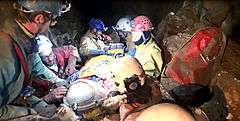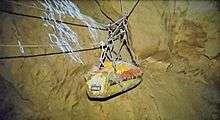Riesending cave rescue
A rescue occurred at Riesending cave between 8 June and 19 June 2014 in Bavaria, Germany, after a speleologist, who had been exploring the cave in a group of three, suffered a traumatic brain injury as a result of a rockfall. It became one of the largest cave rescues in history, involving more than 700 people for eleven days and an estimated cost of close to one million euro.[1]
 Transport of the patient inside the "Riesending" | |
| Date | June 8 to June 19, 2014 |
|---|---|
| Location | Riesending cave |
| Coordinates | 47.6994°N 12.9831°E |
| Cause | Rockfall |
| Participants | German speleologist Johann Westhauser and two colleagues, more than 700 rescue personnel |
| Outcome | Successful rescue with full recovery |
Events
Descending and accident
Around noon on 7 June 2014, speleologist and caver Johann Westhauser and two colleagues descended into the Riesending cave, the deepest and longest pit cave in Germany located in the south-eastern edge of the country on the border to Austria. It is known to be "technically challenging from the first metres on".[2] The next day, 8 June, Westhauser was hit by rockfall around 1:30 am and suffered a brain trauma despite wearing a helmet. At this time, the team had already descended about 1,000 meters (3,280 feet) down the cave. While one of the teammates stayed with Westhauser, the second person started his 10 hour ascent towards the entrance, as there is no radio or cell phone reception inside,[3] a distance of around 6 km (3.72 miles). After reaching daylight and making the urgent call, emergency procedures were initiated.
Rescue operations

On the same evening, three groups of cave rescuers, eleven people in total, entered the cave to make their way towards Westhauser and the remaining teammate. A cave-link system was established to send and receive basic communication signals through solid rock, allowing the exchange of text messages between the cave entrance and the scene of the accident. Further mountain rescue teams from Germany and Austria reached the scene, supported by State- and Federal Police helicopters. On the evening of 11 June, a physician was able to reach the patient.[4] A minor traumatic brain injury was diagnosed and together with a second physician arriving later at night, it was decided that Westhauser was fit to be transported.[3] The paths within the cave had to be secured with additional fixed ropes, bolts and footrests. At peak times, up to 60 people were in the cave and 90% of all cave rescue equipment of the Bavarian mountain rescue (Bergwacht) had been fitted.[5]

The transport through the narrow passages and supplies for the large number of people inside and outside the cave was challenging. The stretcher had been made shock proof to a certain extent. Luckily, Westhauser’s condition stabilized within the days of the rescue operation. There were no engines or other machinery available, so all work had to be done by hand. In vertical passages, the rescue staff used their own bodies as a counterweight to the stretcher. On 19 June at 11:44 am, they reached the surface and exited the Riesending with the help of a manual winch. Westhauser was then transported to the trauma hospital in Murnau via helicopter.
Aftermath
The operation became well known to the general public for the large rescue effort and was called a "chapter of alpine rescue history",[6] taking eleven days by more than 700 members of a multinational group of cave rescuers, consisting of people from Italy, Austria, Germany, Switzerland, Croatia and others. In August, 2015 the interior ministry of Bavaria reported that the costs were estimated around 960,000 Euros, while the victim himself had been "taking responsibility for a substantial amount", although no bill was issued by the state government.[7]
At the end of June, the entrance to the cave was sealed by police to prevent further accidents by curious people and tourists. A special permit is now required and only issued to people with justified interest, physical suitability and professional qualification.
Researcher Westhauser was able to recover from his injuries and slowly started exploring caves again in 2016.[8]
References
- "Höhlenunglück: Riesending-Rettung kostete knapp eine Million Euro - WELT". DIE WELT. Retrieved 2017-06-24.
- "Dem »Riesending« auf den Grund gegangen - Gemeinde Marktschellenberg - Berchtesgadener Anzeiger". www.berchtesgadener-anzeiger.de (in German). Retrieved 2017-06-24.
- Wieland, Andrea (2017-06-02). "Höhlenforschung: Chronik der Höhlenrettung von Johann Westhauser" (in German). Retrieved 2017-06-24.
- Lahrtz, Stephanie (2014-06-11). "Ein Arzt erreicht den Verletzten: Höhlenforscher erlitt Schädel-Hirn-Trauma". Neue Zürcher Zeitung (in German). ISSN 0376-6829. Retrieved 2017-06-24.
- "Forscher Westhauser ist aus der Riesending-Schachthöhle gerettet". ingenieur.de (in German). Retrieved 2017-06-24.
- Geiger, Stephanie; Berlin (2014-06-19). "Nach Forscher-Unglück: Bayerns Innenminister will Riesending-Höhle schließen". Frankfurter Allgemeine Zeitung (in German). ISSN 0174-4909. Retrieved 2017-06-24.
- "Riesending-Drama: Rettung von Höhlenforscher kostete fast eine Million Euro - SPIEGEL ONLINE - Panorama". SPIEGEL ONLINE. SPIEGEL ONLINE, Hamburg. Retrieved 2017-06-24.
- Eisenberger, Korbinian (2016-08-26). "Johann Westhauser kehrt zurück in die Tiefe". sueddeutsche.de (in German). ISSN 0174-4917. Retrieved 2017-06-24.